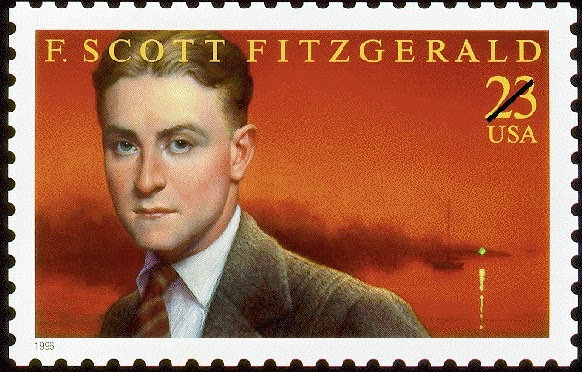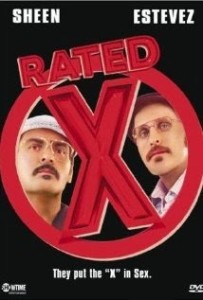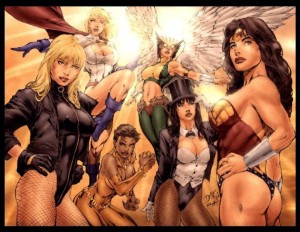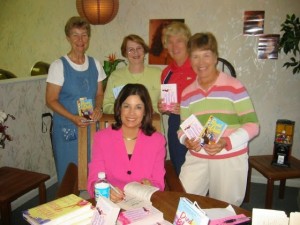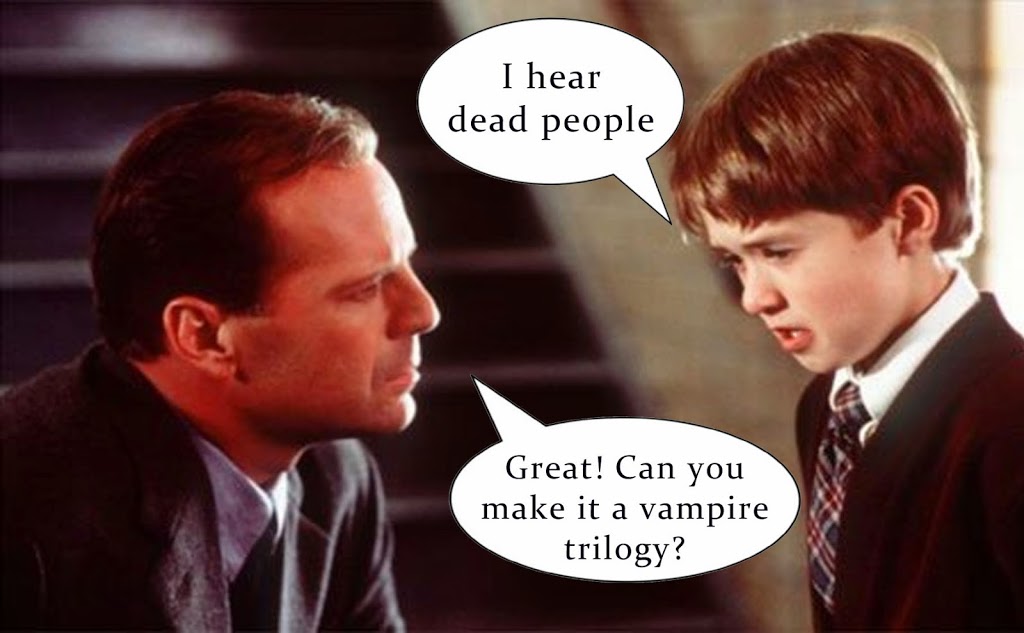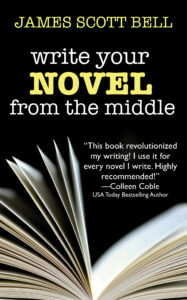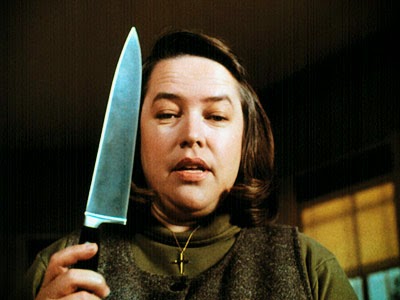“All good writing is like swimming underwater and holding your breath.” – F. Scott Fitzgerald
What is writing like to you?
Yearly Archives: 2014
Word Traps for Unwary Writers
by Elaine Viets
Here are more word traps for unwary writers. I’ve found all these examples in books from major publishers. No, I’m not telling you the authors’ names or the books’ titles. It could happen to any of us. Just be on the look out for these snares. Let’s start with how a missing W can make your book X-rated:
Balling/bawling. I was shocked by this sentence in a well-promoted book: “When they announced I was national champ, my mother started balling.”
Really? In front God and everybody? The simple substitution of a W for one of those Ls would have Mother engaged in public “bawling.” That’s much more socially acceptable.
Colombia/Columbia/pre-Columbian — a triple threat.
Colombia – with an O in the middle. A country in northwest South America, and as any Miami Vice fan knows, the home of violent drug traffickers, including the Cali and Medellin cartels.
Columbia – with a U in the middle. US, the poetic name for the United States. Columbia is also the District of Columbia, better known as Washington, D.C., and a variety of towns and places, including Columbia University, which is currently in a very ugly rape scandal. Poets and headline writers dumped Columbia as the female symbol of the US about 1920 and started carrying a torch for the Statue of Liberty.
Pre-Columbian – with a U in the middle. That means before Christopher Columbus and his European pals started slaughtering and enslaving the indigenous native people in the New World. Er, I mean, before the noble Caucasians brought civilization to the backward savages. This word really trips up writers who discuss pre-Columbian art, especially when it’s located in Colombia, like these sculptures.

Fare-thee-well/Fair-thee-well. Fare-thee-well means “good-bye and good luck” and it’s been used in countless songs and ballads. Here’s a version of the time-honored lyrics:
Fare thee well my own true love
And farewell for a while.
I’m going away, but I’ll be back
If I go ten thousand miles
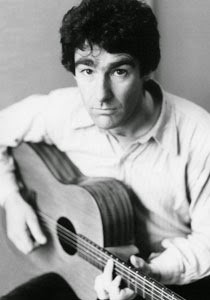
Sound familiar? You’ve listened to versions recorded by folkie Nic Jones as “Ten Thousand Miles,” as well as by Joan Baez, Mary Chapin Carpenter, Marianne Faithfull and more.
“Fair-thee-well” is flat-out wrong. Don’t use it.
Heroine/Heroin. Lately, “heroine addicts” are turning up in way too many novels. These are not readers addicted to the DC Comics heroines.
But drug users craving China white are “heroin addicts.”
Pored/Poured. Way too many people have been “pouring” over books. All that water ruins the pages. It’s easier if you “pore” over your books. 
Ring/Wring. “I could just ring her little neck.” Maybe she was wearing jingle bells. But I think he really wanted to “wring” her neck, which would make her bawl. Those Ws are nothing but trouble.
Rite/Right: “A tattoo is a right of passage,” the author wrote. Wrong. A tattoo is a “rite” of passage. Got that right?
Good luck, writers. Go and sin no more.
14 Questions People Ask Writers
As a writer, you might encounter the following questions during the course of your career. Preparing answers ahead of time will prevent you from becoming tongue-tied when hit with one of these verbal arrows. If you feel left out, don’t worry. Once you get published, these people will jump out of the woodwork.
1. At Thanksgiving dinner, your cousin comes up to you, leans forward and speaks in a conspiratorial tone. “I have this great idea for a story. Would you be interested in working with me on it?” Before he launches into a lengthy and convoluted plotline, give this response: “I have more ideas than I can write, thank you, but I know another author who acts as a ghostwriter. He charges $10,000 per book. Shall I put him in touch with you?”
2. “I have a friend who’s written a book, and she needs someone to edit it. She’s desperate for help. Can I give her your phone number?” Let this person know that your services, if available, are not free. You would require a fee, a contract, and a waiver of liability. Or suggest she gain feedback by joining a critique group or entering a writing contest with score sheets. Another alternative is for her to hire a professional freelance editor, but you still have to make clear it’s a long road ahead. See Question Number 8.
3. You are in the doctor’s office, and he asks your line of work. “Really?” the doctor says after you reply that you’re a writer. “What do you write?”
“I write mystery novels.”
“Are they, you know, published?”
“Yes, I’ve written over twenty books. You can buy them online.”
“That’s impressive. I’ve been thinking about writing a book. How do you get published?”
“You join a professional writing organization, attend meetings and workshops, go to writing conferences, and learn the business aspects of the career along with the craft. I’d love to talk more about it. How about if we exchange an hour of my time for an hour of yours?”
4. “How are your books doing?” is another question you might get from friends and family. Here’s your answer: “They’re doing great, thank you. Have you bought a copy yet?”
Another writer once told me she’d like to say her books had failed, she had entered bankruptcy proceedings, and did anyone want to help her out with some cash?
5. “Where do you get your ideas?” is a common question at book talks. Well, I pull them out of thin air, don’t you? You’d think this one would be a no-brainer, but it’s a question that genuinely baffles people. Ideas are all around. It’s having time to write these stories that’s difficult.
6. “Are you making money at it?” I’d really like to reply, “No, I’m starving, and I need a loan.” Many people think published authors are rich and famous. “I guess you earn a good living, right?” is another variation. Some folks will come right out and say, “So how much do you get for each book?” That’s like asking your doctor, “So how much do you make on each patient?” I have a standard response: “I write because I love to tell stories. My advice to new writers: Don’t quit your day job.”
7. “I want to write a book, but I don’t have time to learn the ropes. Can I pay you to write it for me?” See answer to Number One. Add a bit on the publishing biz and how writers are expected to spend time promoting their novel. Even if someone else writes the book for them and it sells, are they willing to put the time into marketing?
8. “Can you recommend a book doctor?” My answer: “If you’re serious about becoming a writer, you’ll learn how to edit your own work. All careers require practice and training, and writing books is no different. The only magic bullet is persistence. But you can hire a freelance editor to help you in the right direction. This still won’t guarantee a sale. Plus, publishers expect more books than one work. You’ll need to start on book number two right away, and be prepared to do your own marketing.”
9. “Can I find your book in the library?” Librarians order books, so we want patrons to request them. But this question could be a good opportunity to launch into an explanation about the sources of distribution and the different formats for books today. You could counter with, “Do you like to read your books in print or on ebook?” And even if the person gets your book at the library, encourage him to write an online customer review.
10. “Where can I find an agent?” Hello, anyone hear of the Guide to Literary Agents? The AAR site online? Attending professional conferences? Entering writing contests? Let this person know about local writers organizations, classes, and seminars. They need to do their homework. And no, I am not going to introduce them to my agent.
11. “Is your book on the bestseller list?” This one is easy to answer: “Not yet, but if you buy a copy and tell all your friends about it, that will help me get there.”
12. “Have you been on any talk shows?” The line is blurred here between the concept of an Author and a Celebrity. Becoming a published author may take years of learning, rejections, submissions, and rewrites. Celebrity equates to stardom. Serious writers work at the craft because they love to write. They know it is not an easy road to follow, and they’re willing to put in the effort, suffer the indignities, and keep going regardless of whether fame or fortune come their way.Your answer: Repeat the one from Number 11.
13. “I’ve never heard of you. Are your books in the bookstore?” Again, this is a good opportunity to mention the various platforms for distribution.
14. “Any chance of getting your book made into a movie?” Realistic answer: “Unfortunately, it’s not up to the author. The publisher may [or may not, depending on your circumstances] own the film rights. An agent might be approached by a studio or interested party who pays a fee to option the book. But even then, that might go nowhere. So the chances are slim for most authors.”
Many of your answers will be individual based on your preferences. Consider every encounter an opportunity to educate the public about the publishing industry and what they, as readers, can do to help authors.
What we write comes from the heart. It’s our personal expression, not ideas we pluck from someone else’s consciousness or can teach in a quick lesson. Each person’s journey is his own. We get where we are through hard work, grit, a thick skin, and persistence.Yes, we can offer tips and point wannabe writers in the right direction, but they have to be prepared to do the work. And they have to love telling stories.
So how would you answer some of these questions above?
Listening to Your Characters
“I hear voices in my head, and if I remember correctly, I always did.” — Stephen King
So I’ve got my protagonist Clay Buchanan at a critical point in the story. He’s just done something awful, faced his “mirror moment” as James Bell calls it. And now he’s sitting in a dive bar, two sheets to the wind, thinking about what has brought him to this crisis.
My fingers are poised over the keys, waiting…
Waiting for him to tell me what is on his mind.
((((Silence))))
Clay? You there, buddy?
(((Cickets)))
Dude, I really need you to talk to me.
(((Goin’ dark)))
Oh man, is there anything worse than characters who won’t talk to you? It doesn’t often happen to me but when it does, it brings my writing momentum to a screeching halt. It is something I can’t just “write through” and hope I can go back and fix it later. Because when a character refuses to reveal himself to me, refuses to let me inside to hear his thoughts, I lose the heartbeat of my story.
Most writers, I think, hear voices in their heads. Yes, we visualize our stories, seeing the action unreeling in our heads like movies. But we also hear the speech and thoughts of our characters, as if we are mere conduits for voices that seem to have lives of their own. Writing is, after all, just “a socially acceptable form of schizophrenia,” according to E.L. Doctorow.
Hearing voices is on my mind of late not just because of my recalcitrant character Clay. But also because I read about a fascinating project called Hearing The Voice. As part of medical project on auditory hallucinations at Durham University in the UK, researchers are surveying novelists about how they experience their character’s voices. They’ve gathered info from more than 100 authors, including Hilary Mantel, Virginia Woolf and Charles Dickens.
And here you thought you were the only “loony” one.
The questions are intriguing: What does inner voice actually “sound” like? What is like to hear your characters or subjects out loud? What do writers do when they can no longer “tune in” to their inner voice? (Hello? Anyone want to interview me?)
Here are some interesting findings:
- Writers tend to “experience their primary and secondary characters differently. They have a sense of “inhabiting the interior life” of their protagonist and of looking out at the world through their eyes. But they report that secondary characters tend to be experienced visually.
- Many writers are unable to “see” the faces of their protagonists. The main character often registers as a blank – or, in one case, pixelated like a censored photograph.
- Writers’ engagement with their inner voice, and the role it plays within the literary-creative process, changes radically over the course of their careers. Early on, they report little separation between their own thoughs and those of characters. Over time, however, writers report that the inner voice becomes more complex, taking on echoes of other voices harvested from life and literature.
“Worked up?” I offered a vaguely contemptuous snort. “I feel like Meursault in The Stranger.”
“Be sure you mention that to the press, or better yet, the jury. I’m sure they’re all great fans of postwar existential French literature.”
“My grandfather would have shot you with one of the dueling pistols I still have,” he said. “But I fear I lack the courage required to defend my honor.”
This is another professor but in the legato rhythm, ripe vocabulary, and fey tone, Cook has conveyed volumes about this man’s background (genteel Southern) and personality (timid cuckold).
Here’s another example, this time from one of my favorite movie scripts:
Crash Davis: After 12 years in the minor leagues, I don’t try out. Besides, uh, I don’t believe in quantum physics when it comes to matters of the heart.
Annie Savoy: What do you believe in, then?
Crash Davis: Well, I believe in the soul, the cock, the pussy, the small of a woman’s back, the hanging curve ball, high fiber, good scotch, that the novels of Susan Sontag are self-indulgent, overrated crap. I believe Lee Harvey Oswald acted alone. I believe there ought to be a constitutional amendment outlawing Astroturf and the designated hitter. I believe in the sweet spot, sex hd xxx soft-core pornography, opening your presents Christmas morning rather than Christmas Eve and I believe in long, slow, deep, soft, wet kisses that last three days. [pauses then winks and walks away]
Annie Savoy: Oh my. Crash…
Nuke LaLoosh: Hey, Annie, what’s all this molecule stuff?
In this exchange, we find out all we need to know about the intellectual level of these two baseball players.
Maybe we should also take a quick look at the mechanics of how we convey character’s voices. Dialogue mechanics are pretty straightforward. But I find some inexperienced writers have trouble with interior monologues. Maybe it’s because dialogue is SHOWING, but to convey a character’s thoughts, you must move into narrative mode, which technically is TELLING. And many writers believe that will slow things down too much. I disagree. A good interior monologue gives the reader a window into a character’s soul. Yes, you can convey what a character is thinking or feeling through speech, facial expressions and movement. But sometimes readers also need to “hear” what is in their heads and hearts. It cements the emotional bond.
Interior monologues can be short or long. Short ones are one- or two-sentence thoughts inserted into an action scene or dialogue. Long interior monologues can go on for paragraphs or pages and because they slow the pace, you have to be careful where you put them.
Another mechanical consideration: Do you use “I thought” or “he thought” or do you simply signpost a thought with italics? I like to use both. Here’s a sample from my WIP, the thoughts of my stubborn character Clay:
YOLO. It was a dumb name for a restaurant, he thought. But then when he glanced at the matches he had snagged from the hostess he saw that it stood for You Only Live Once.
He ordered a Martin Mills bourbon. Hundred bucks a shot, but he wasn’t paying. He took a sip, closing his eyes in pleasure at the caramel taste.
Carpe diem, baby.
Oh God, what have I done?
But never:
I think I’ll have egg salad for lunch.
Alex stared at the back of Buchanan’s head, a spasm of disgust moving through him, like that time that rapist had reached through the bars of the Tallahassee jail and grabbed his arm, grinning and saying he had never touched that little girl. Alex had gotten the man off. Two months later, he quit his public defender job and signed on with a small Orlando firm specializing in corporate law. It wasn’t only for the money. He just wanted to feel clean.
And speaking of my characters, Clay decided about a half-hour ago that he was going to start talking to me again. Originally, I had thought his mirror-moment had left him depressed. Then I thought it had left him angry. Well, I realized it was neither. I was confused about his motivation and well, I wasn’t really listening to him.
Now I can’t shut him up. So if you’ll excuse me, I’m going back to chapter 22 before he decides to clam up again.
POV 102 – How to Avoid Head-Hopping
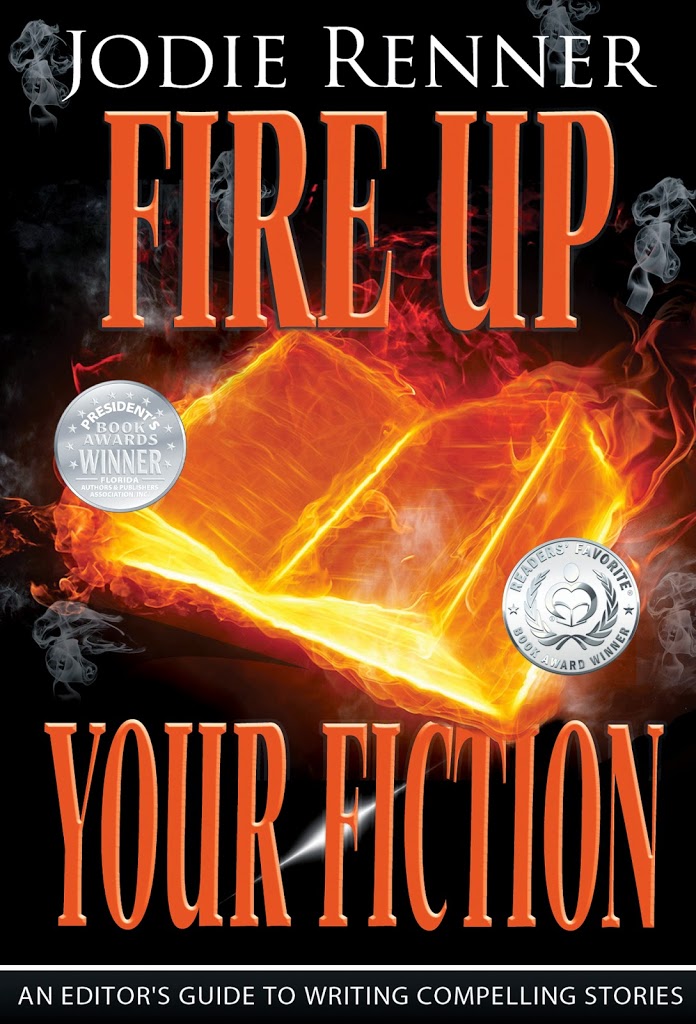 by Jodie Renner, editor, author, speaker @JodieRennerEd
by Jodie Renner, editor, author, speaker @JodieRennerEd
In POV 101 – Get into your protagonist’s head and stay there, I discussed the effectiveness of starting out your story in your protagonist’s point of view and staying there for most of the novel.
But what if you want to show how other people are feeling? If they’re important characters, like the villain, a romantic interest, or a close friend or family member, you can give them their own POV scenes, where you get into their heads and we see their thoughts, emotions, goals, aspirations and fears.
If they’re in the same scene as your main character, you show their thoughts, feelings and attitude only through what your protagonist can perceive—their words, tone of voice, body language and facial expressions. Say you’re writing a romantic suspense or mystery, and you’re in the heroine’s point of view, showing her thoughts, perceptions and reactions. The hero, whom she’s just met under unfortunate circumstances, is angry. You’ll show his thoughts and reactions, not from inside him at that point (What the hell is going on here? he thought. What’s she trying to pull off, anyway?), but by what the heroine is seeing and hearing—his tense posture, hunched shoulders, clenched fists, furrowed brows, set mouth, clipped tone of voice, angry words, etc.
The general rule of thumb is “one scene, one viewpoint.” Or even better, wait for a new chapter to change the point of view to someone else’s. If you change the viewpoint within a scene, it’s best to do it only once, and leave a blank space before you start the next person’s point of view. Ping-ponging back and forth can be jarring and confusing to the reader. This is what’s referred to as “head-hopping.” Some writers go so far as to leave three asterisks (* * *) and spaces above and below to indicate a switch in viewpoint within a scene, but I think that’s too jarring and disruptive to the flow of action, since we’re still in the same scene. Three asterisks, centered, are best reserved to indicate a shift in place and time.
So why is it so important to avoid switching viewpoints (head-hopping) within scenes?
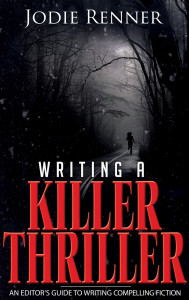 According to Cynthia VanRooy, “When a reader becomes emotionally engaged in a book, he or she enters into the story. The reader understands the book world isn’t real, but in order to fully enjoy the story, he or she chooses to temporarily pretend otherwise, or to suspend their disbelief. […]
According to Cynthia VanRooy, “When a reader becomes emotionally engaged in a book, he or she enters into the story. The reader understands the book world isn’t real, but in order to fully enjoy the story, he or she chooses to temporarily pretend otherwise, or to suspend their disbelief. […]
“Every time you shift the reader from one character to another, they are jarred out of their suspension of disbelief and reminded that they’re only reading a story. Do that often enough and they’ll stop reading your story. Scene changes or new chapters are the best and least disruptive places to change POV.”
Here’s an example of a viewpoint gaffe, which I made up:
Our heroine, Carole, is stirring the spaghetti sauce on the stove and talking to her husband on the phone. They’re discussing the fact that their son, Colton, is grounded. Suddenly, the author jumps into her son’s head and tells us about Colton sneaking by behind her back (his rap music is playing loudly in his room), and out the front door, then jumping on his bike and racing off. Back to Carole, who continues to stir the spaghetti and talk on the phone.
What’s wrong here? We were in Carole’s POV, and she had her back turned so she wouldn’t know Colton was sneaking past, especially with all that noise coming from his room. And how would she know he’s riding away on his bike? Another jarring POV shift in the same scene would be if we suddenly started seeing her husband waving his secretary away because he’s in an important conversation. We’re in Carole’s POV in this scene, and she can’t see what her husband is doing at his office.
Here’s another example of ping-ponging point of view, where we the readers jump back and forth over miles, within seconds.
We start out in Steve’s point of view, who’s in trouble and has just picked up the phone and called his wife, Grace:
“Grace, thank god you’re home. This is all too much for me. My life is crumbling around me and I can’t seem to do anything about it,” Steve said, closing his eyes and rubbing his face.
The sadness and despair in his voice brought tears to Grace’s eyes.
“I have to think.” There was long pause before Steve continued. “Luckily, George is right here. I’ll ask if he knows a good attorney who can help with this.”
“That sounds good.” She felt some relief.
“I’ll call you later,” Steve said, then hung up and slumped back in his chair.
“I’ll be waiting,” she said softly. The call ended before she could say I love you.
What’s wrong with how this scene is written?
Choose either Steve or Grace and play the scene from his or her POV. Show us only what he or she can see, hear, and perceive.
A quick way to check whose POV you’re in is to get out the highlighters or colored pens and choose a different color for each of your main characters. Pick your protagonist’s color, then start highlighting or underlining sentences that describe scenes, people, perceptions, and emotions strictly from his or her POV. Do the same for other characters, with their color. When you’re done, you should have paragraphs, and preferably scenes, of only one color. If you have another color creeping into that scene, see if you can rewrite those sentences from the dominating character’s POV. If you have a number of colors within one scene, you’ve got some revisions to do. And as Stephen King says, “Writing is rewriting.”
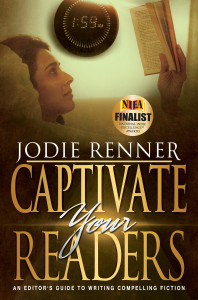 By the way, my third book, Captivate Your Readers, gets into a lot of detail on engaging your readers and bringing your story and characters to life by using deep point of view, showing instead of telling, and stepping back as the author to let the characters tell the story in their own voice.
By the way, my third book, Captivate Your Readers, gets into a lot of detail on engaging your readers and bringing your story and characters to life by using deep point of view, showing instead of telling, and stepping back as the author to let the characters tell the story in their own voice.
Also, check out POV 103 – Engage Your Readers with Deep Point of View here on TKZ. And check out the handout to my workshop “Engage the Readers with Deep Point of View” on my own blog.
Jodie Renner is a freelance fiction editor and the award-winning author of three craft-of-writing guides in her series An Editor’s Guide to Writing Compelling Fiction: Captivate Your Readers, Fire up Your Fiction, and Writing a Killer Thriller. She has also published two clickable time-saving e-resources to date: Quick Clicks: Spelling List and Quick Clicks: Word Usage. You can find Jodie at www.JodieRenner.com, www.JodieRennerEditing.com, her blog, http://jodierennerediting.blogspot.com/, and on Facebook, Twitter, and Google+.
Revisiting the Mirror Moment
Please allow me a bit of shameless self-promo, because it involves Kevin Costner. No, he’s not contacted me about filming one of my books (though he should). It’s about one of his older movies. Stay with me.
Hi James,I own so many of your books, so I want to email you about a small epiphany I had. I recently bought “Write Your Novel From The Middle” and, jaded as I am about writing books, read it with some interest but not much conviction.Two weeks later, I’m elbows-deep in the guts of a novel I wrote 7 years ago, and cutting. I mean, I’m slicing and dicing like Freddy Krueger, blood and guts everywhere. I took 20k out of a 127k novel.And there was that weird passage where my main character has a health crisis (he essentially screws up his immune system from overwork, but he thinks it’s something worse) and basically lies flat on his back in his bedroom, waiting to die.And he realizes that due to the path he’s chosen, he’s completely alone on the planet, in London, and nobody cares if he lives or dies. It’s a moment of great weakness, self-pity and the existential crisis that propels him – once he gets better – to really work that human interaction, make friends, network. (He’s in finance, so being good with people is important). Long story short, I really gutted the book, cut that scene down by at least half, and some editors said I should cut it entirely, but for me it was weirdly important. It felt powerful, and it wasn’t the typical “kill your darlings” kind of vanity on my part. I knew it was important, so I only condensed it and kept it in place.The book then went to layout. It was exactly 400 pages in PDF.Guess where that scene fell? Pages 202 and 203. If you take out the front matter/cover, it’s SMACK BANG in the middle.I admit I guffawed.Thank you for putting your writing advice out there. You definitely blew my mind this time.All the best,Aleks
It’s my contention that knowing your book’s mirror moment illuminates the entire novel better than any other single technique. And the great thing is you can do this at the beginning, middle or end of your draft. You can use it whether you’re plotting or pantsing your way through.
Learning from Stephen King
Reader Friday: A Tip of the Hat
Top Three Tips for Getting Published
Today we welcome our guest, friend and TKZ emeritus, Michelle Gagnon filling in for Jordan Dane.
—————————
On the road to publication, I was fortunate to receive many tips and pointers along the way. Today I wanted to offer the three pieces of advice that had the biggest impact.
Getting published was an extremely long and tortuous process for me.
More than a decade ago, I started compiling a series of short stories into a novel. Like many debut novels, it didn’t have much of a story arc, and was largely autobiographical (sounds great, right? J). Convinced that it would be an instant bestseller, I immediately send it off to dozens of literary agents.
Then the rejections started rolling in. I seriously must have set some sort of record; by the end, more than 50 agents had passed on it.
A few wrote lovely letters, encouraging me to try again. But frankly, I was heartbroken. By that point, the book represented years of my life; time I would never get back.
So I stopped writing for a few months. Then by chance, I attended an author event. Lee Child spoke about how it usually took a decade to become an “overnight success story.” And he explained that in his opinion, the authors who succeeded were the ones who didn’t give up.
I’d come close to doing just that. But the next day, I started writing another book. That book became THE TUNNELS; the first literary agent I sent it to offered to represent me (and mind you, this was an agent who had rejected my first novel).
So tip #1: never give up
–Don’t pick up that red pencil until you’ve reached the end
I meet a lot of writers who have written 50, or 100 pages of a book. And that’s precisely when a lot of them give up. Listening to them, I’ve figured out why: when they got to that point, they went back and started editing their work.
Granted, everyone has a different process, but here’s my advice: don’t start editing AT ALL until the bones of the story are in place. I’m currently finishing the rough draft of my 12th novel; and when I say rough, believe me, it’s no exaggeration. The manuscript is riddled with typos, overwrought metaphors, and clunky dialogue. I accept that much of the time, I’m going to despise what’s appearing on the page. But I grit my teeth and keep going, because the rough draft is called that for a reason. It’s all about getting the bones of the story in place. Later, I’ll end up reworking it chapter-by-chapter, scene by scene; I usually make between 15-20 passes on every book I write. So there’s plenty of time to fine tune it later.
The problem with editing as you go is that it’s a much slower process. I usually write 10 pages a day; during the editing process, I’m lucky to get through 3. So when a first time writer finally gets back to page 50, after perfecting those opening chapters, it’s daunting; like looking up at Everest, and realizing that you’ve barely reached base camp. Many, many people give up at that point. Avoid that by not stopping until you reach the end.
–You don’t have to write every day
Stephen King famously claims to write 4 hours a day, and read 4 hours a day. Every time I hear that, all I can think is that he probably never has a day that starts with driving carpool, followed by a PTA meeting, then returning home to discover that the water heater burst and somehow he has to get that fixed and clean all the water up off the floor.
Or maybe he does, I don’t honestly know. But the truth is, we’re not just writers, we’re people too; with families and pets and homes to maintain. We need to go grocery shopping and pay the bills. We need to take care of the people in our lives, and sometimes that doesn’t leave a lot of extra time to work on our manuscripts.
And you know what? That’s okay. Because here’s the thing: even if you only write one page a day, by the end of a year, you’ll have a book. And if you manage to write five pages one day, and nothing for the next four days: same result.
I write when I can, for as long as I can. And there are days—heck, weeks—when I don’t write at all. I don’t bring a laptop on vacation; I don’t take it with me for family visits. It’s not always easy to get back into the groove of a story after a long absence, but it’s manageable. And preferable to not writing at all. So don’t buy into the myth that a “real” writer spends every spare minute slaving away at their keyboard, because by and large, that’s not the case.
I hope these three tips are helpful; I honestly wished that I’d known them when I was starting out. So persevere, plow through your rough draft, and know that skipping a few days doesn’t make you any less of a writer.
We all take different paths to publication; the important thing is that we all end up at the same place.
Michelle Gagnon
Michelle Gagnon is the international bestselling author of thrillers for teens and 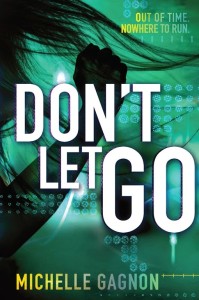 adults. Described as “The Girl with the Dragon Tattoo meets The Bourne Identity,” her YA PERSEF0NE trilogy was nominated for a Thriller Award by the International Thriller Writer’s Association, and was selected as books of the year by Entertainment Weekly Magazine, Kirkus, Voya, and the Young Adult Library Services Association. The final installment, DON’T LET GO, was just released. She splits her time between San Francisco and Los Angeles.
adults. Described as “The Girl with the Dragon Tattoo meets The Bourne Identity,” her YA PERSEF0NE trilogy was nominated for a Thriller Award by the International Thriller Writer’s Association, and was selected as books of the year by Entertainment Weekly Magazine, Kirkus, Voya, and the Young Adult Library Services Association. The final installment, DON’T LET GO, was just released. She splits her time between San Francisco and Los Angeles.
Tosca Lee On Research
Today, I welcome to TKZ my friend and fellow ITW member, New York Times bestselling author, Tosca Lee. Because of the historical nature of so much of Tosca’s writing, I asked her to share her thoughts on research. Enjoy!
Joe Moore
—————–
I’m asked often how I research my historical novels. I’ve steadfastly avoided writing about this topic until now I think because it’s such a personal process—one dictated by how a  person sorts, digests, and stores information. None of us will do it the same. That said, having had to pack the equivalent of a dissertation’s worth of research into six months on occasions before, I have picked up a few tricks.
person sorts, digests, and stores information. None of us will do it the same. That said, having had to pack the equivalent of a dissertation’s worth of research into six months on occasions before, I have picked up a few tricks.
1) Start pedestrian. Do what everyone else does: Google. Wikipedia. YouTube. See what’s available on Amazon. Read and watch widely.
2) Acquire key references for your library. These are the staple works and experts that books, articles and documentaries about your topic refer to time and again. For the first century, it’s the historian Josephus. For period warfare, Carl Von Clausewitz. Find your staple information.
3) Find specialty outlets. This is where I divert to the History Channel. National Geographic. The Discovery Channel. Coursera. Two of my power tools: The Great Courses and the (in my opinion) less-utilized and under-appreciated iTunes U. These last two, in particular, are rich sources of highly-organized, consumable information by leading experts and ivy-league academics. True, the Great Courses are not cheap. If scrimping, look for the course on eBay, or order only the transcript. iTunes U. is free.
4) Identify your experts—the writers of the staple books (or their commentaries), the leading academics or specialists teaching the lectures or commenting in the documentaries. These may also be area experts or locals living in your setting (travel guides, bloggers and book authors are excellent for this) or doing what they do.
5) Recruit. I never write a novel without at least a small group of experts in my pocket to either point me in the direction of information I need or to directly and expediently answer a question as I’m working. Don’t be afraid to write and introduce yourself and how you came to find them. Be direct with queries and questions, and therefore respectful of their time. Curators of specialized information are eager to help someone who shares their enthusiasm. Offer them the gift of some of your previously published work if they express willingness, and a consulting fee if you have the resources. If you find yourself relying on their help at regular intervals, be gracious with a token of appreciation. And of course remember them in your acknowledgments and with a finished copy of the project. Having made friends with several of my sources, the research has become easier; when I start a project in the purview of one of them, I ask for a starting bibliography, which cuts down on steps 1 and 2.
Of course you need a general idea what you want to accomplish when you start researching. That said, I have found it most helpful to let the research inform my outline, particularly in writing historical fiction. I find it most helpful to let the political, cultural and religious climate of a point in history inform my characters’ backstory and upbringing. In fact, I have three rules as I create historical characters in particular: their lives must adhere to or put an interesting (but plausible) twist on their historical record; their lives and actions must be in keeping with their political and cultural setting (even a visionary is only a visionary relative to setting); and ultimately, their pains, joys and actions must ring true to human nature.
My research library for my first book consisted of some fifteen items. My library for Iscariot, more than 100. There’s an inherent risk in so much information and it is this: the temptation to put every tasty morsel of obscure but fascinating information into your prose.
Don’t do it.
Despite my telling myself this advice, my first draft of Iscariot was 800 pages. Part of that is my own habit of over-writing first drafts. The other part of that was an overabundance of interesting stuff. Too much clever innuendo that required first educating the reader.
Readers are not reading fiction to be educated, but entertained (or else they would be reading the same research material as you). Take the time to read and absorb everything pertinent—not for their sake, but yours. Sort your information in a way that you can find what you need when you need it. These days, I organize information by topic in Scrivener. But having absorbed everything I’ve read, listened to, and watched, I try to push it all away when I sit down to write. I let loose, keeping maps or immediate references nearby if necessary, but adding historical details in very small doses later—and mostly to the first part of the novel, where I am buying credibility with the reader.
Save yourself the trouble of hashing through a barrage of information by cutting to the heart of your story from the get-go. Because ultimately, the storyline that will draw and keep your readers is not the product of your diligent research (that will only keep you out of hot water with the critics)… but the emotional connection with a character’s hopes, dreams, failures and fears—the things that bind us all, regardless of time and place.
—————–
Tosca Lee is the award-winning, New York Times best-selling author of Iscariot; Demon: A Memoir; Havah: The Story of Eve, and the Books of Mortals series with New York Times best-seller Ted Dekker (Forbidden, Mortal and 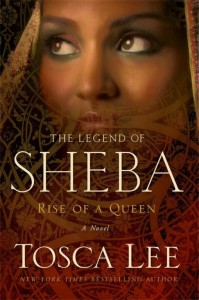 Sovereign). Her highly anticipated seventh novel, The Legend of Sheba, releases September 9, 2014.
Sovereign). Her highly anticipated seventh novel, The Legend of Sheba, releases September 9, 2014.
Tosca received her B.A. in English and International Relations from Smith College in Northampton, Massachusetts with studies at Oxford University. She is a lifelong world adventure traveler and makes her home in the Midwest. To learn more about Tosca, visit www.toscalee.com.
For a limited time, download ISMENI, the eShort prequel to SHEBA for free.

